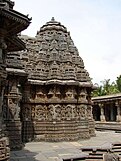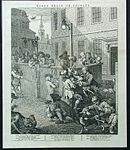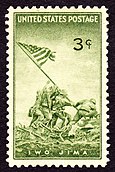Portal:Visual arts/Selected article
| This Wikipedia page has been superseded by Portal:Visual arts and is retained primarily for historical reference. |
| Note: Article entries are now being transcluded directly on the main portal page. However, this page should be retained for historical reference. |
Selected article 1
Portal:Visual arts/Selected article/1
The Four Stages of Cruelty is a series of four printed engravings published by William Hogarth in 1751. Each print depicts a different stage in the life of the fictional Tom Nero. Beginning with the torture of a dog as a child in the First stage of cruelty, Nero progresses to beating his horse as a man in the Second stage of cruelty, and then to robbery, seduction, and murder in Cruelty in perfection. Finally, in The reward of cruelty, he receives what Hogarth warns is the inevitable fate of those who start down the path Nero has followed: his body is taken from the gallows after his execution as a murderer and is mutilated by surgeons in the anatomical theatre.The prints were intended as a form of moral instruction; Hogarth was dismayed by the routine acts of cruelty he witnessed on the streets of London. Issued on cheap paper, the prints were destined for the lower classes. The series shows a roughness of execution and a brutality that is untempered by the humorous touches common in Hogarth's other works, but which he felt was necessary to impress his message on the intended audience. Nevertheless, the pictures still carry the wealth of detail and subtle references that are characteristic of Hogarth. (Full article...)
Selected article 2
Portal:Visual arts/Selected article/2
Buddhist art originated on the Indian subcontinent following the historical life of Gautama Buddha, 6th to 5th century BCE, and thereafter evolved by contact with other cultures as it spread throughout Asia and the world.Early Buddhist art, followed the Indian aniconic tradition which avoids direct representation of the human figure. Around the 1st century CE an iconic period emerged lasting to this day which represents the Buddha in human form.
Buddhist art followed believers as the dharma spread, adapted, and evolved in each new host country. It developed to the north through Central Asia and into Eastern Asia to form the Northern branch of Buddhist art, and to the east as far as Southeast Asia to form the Southern branch of Buddhist art. In India, Buddhist art flourished and even influenced the development of Hindu art, until Buddhism nearly disappeared in India around the 10th century due in part to the vigorous expansion of Islam alongside Hinduism. (Full article...)
Selected article 3
Portal:Visual arts/Selected article/3
Dürer's Rhinoceros is the name commonly given to a woodcut created by German painter and printmaker Albrecht Dürer in 1515. The image was based on a written description and brief sketch by an unknown artist of an Indian rhinoceros that had arrived in Lisbon earlier that year. Dürer never saw the actual rhinoceros, which was the first living example seen in Europe since Roman times. In late 1515, the King of Portugal, Manuel I, sent the animal as a gift for Pope Leo X, but it died in a shipwreck off the coast of Italy in early 1516. A live rhinoceros was not seen again in Europe until a second specimen arrived from India at the court of Philip II in Spain in around 1579.Despite its anatomical inaccuracies, Dürer's woodcut became very popular in Europe and was copied many times in the following three centuries. It was regarded as a true representation of a rhinoceros into the late 18th century. Eventually, it was supplanted by more realistic drawings and paintings, particularly those of Clara the rhinoceros, who toured Europe in the 1740s and 1750s. It has been said of Dürer's woodcut: "probably no animal picture has exerted such a profound influence on the arts". (Full article...)
Selected article 4
Portal:Visual arts/Selected article/4
The National Gallery is an art gallery in London, located on the north side of Trafalgar Square. It houses Western European paintings from 1250 to 1900 from the national art collection of Great Britain. The collection of 2,300 paintings belongs to the British public, and entry to the main collection is free, although there are charges for entry to special exhibitions.Despite having been founded without an existing royal collection on which to build, the National Gallery has grown to be a collection of international renown since its foundation in 1824. It was shaped mainly by its early directors, including Sir Charles Lock Eastlake, and by private donations, which comprise two-thirds of the collection. Although small in comparison with other national art collections such as the Louvre, the National Gallery is notable for covering a broad art-historical scope with paintings of consistently high quality, making it possible to trace every major development in Western painting from the Early Renaissance to the Post-impressionists through its collection. The Gallery's 19th-century origins have, however, resulted in particularly strong holdings of the Italian and Dutch schools, while historically it was slow on the uptake of modern art. (Full article...)
Selected article 5
Portal:Visual arts/Selected article/5
Raising the Flag on Iwo Jima is an iconic photograph taken on February 23, 1945 by Joe Rosenthal. It depicts five United States Marines and a U.S. Navy corpsman raising the Flag of the United States atop Mount Suribachi during the Battle of Iwo Jima in World War II. The photograph was instantly popular, being reprinted in hundreds of publications. Later, it became the only photograph to win the Pulitzer Prize for Photography in the same year as its publication, and ultimately came to be regarded as one of the most significant and recognizable images in history, and possibly the most reproduced photograph of all time. Of the six men depicted in the picture, three (Franklin Sousley, Harlon Block, and Michael Strank) did not survive the battle; the three survivors (John Bradley, Rene Gagnon, and Ira Hayes) became suddenly famous. The photograph was later used by Felix de Weldon to sculpt the USMC War Memorial, located just outside Washington, D.C. (Full article...)Selected article 6
Portal:Visual arts/Selected article/6

The building is commonly dubbed as "The House With Chimaeras" because it contains various scenes depicting exotic animals and hunting scenes, as Gorodetsky was an avid hunter. It is situated on № 10, Bankova Street, across from the president of Ukraine's office in the historic Pechersk neighbourhood of Kiev. It is currently used as a presidential residence for official and diplomatic ceremonies.
The Italian sculptor Emilio Sala made both the internal and external sculptural decorations, such as mermaids, dolphins, and frogs on the roof of the building, sinking ships and hunting trophies on the exterior walls, and exuberant interior decorations, such as grand stairways and chandeliers depicting huge catfish strangled in the stems of lotus flowers. (Full article...)
Selected article 7
Portal:Visual arts/Selected article/7 Campbell's Soup Cans (sometimes referred to as 32 Campbell's Soup Cans) is the title of an Andy Warhol work of art that was produced in 1962. It consists of thirty-two canvases, each measuring 20 inches in height x 16 inches in width (50.8 x 40.6 cm) and each consisting of a painting of a Campbell's Soup can—one of each canned soup variety the company offered at the time. The individual paintings were produced with a semi-mechanised silkscreen process, using a non-painterly style. They helped usher in Pop art as a major art movement that relied on themes from popular culture.
For Warhol, a commercial illustrator who became a successful author, painter and film director, the work was his first one-man gallery exhibition as a fine artist. This gallery exhibition at the Ferus Gallery in Los Angeles, CA marked the west coast debut of Pop art. The combination of the semi-mechanized process, the non-painterly style, and the commercial subject initially caused offense, as the work's blatantly mundane commercialism represented a direct affront to the technique and philosophy of Abstract expressionism. (Full article...)
Selected article 8
Portal:Visual arts/Selected article/8

The vigorous temple building activity of the Hoysala Empire was due to the social, cultural and political events of the period. The stylistic transformation of the Karnata temple building tradition reflected religious trends popularized by the Vaishnava and Virashaiva philosophers as well as the growing military prowess of the Hoysala kings who desired to surpass their Western Chalukya overlords in artistic achievement. (Full article...)
Selected article 9
Portal:Visual arts/Selected article/9
Northwest Coast art is a style of art created primarily by artists from Tlingit, Haida, Tsimshian, Kwakwaka'wakw and Nuu-chah-nulth First Nations of the northwest coast of North America, from pre-European-contact times up to the present.Northwest Coast art is distinguished by the use of form lines, and the use of characteristic shapes referred to as ovoids, U forms and S forms. Before European contact, the most common media were wood (often Western red cedar), stone, and copper; since European contact, paper and canvas have also been used. If paint is used, the most common colours are red and black, but yellow is also often used, particularly among Kwakwaka'wakw artists.
The patterns depicted include natural forms such as bears, ravens, eagles, and humans; legendary creatures such as thunderbirds and sisiutls; and abstract forms made up of the characteristic Northwest Coast shapes. Totem poles are the most well-known artifacts produced using this style. Northwest Coast artists are also notable for producing characteristic "bent-corner" or "bentwood" boxes, masks, and canoes. Northwest Coast designs were also used to decorate traditional First Nations household items such as spoons, ladles, baskets, hats, and paddles; since European contact, the Northwest Coast art style has increasingly been used in gallery-oriented forms such as paintings, prints and sculptures. (Full article...)
Selected article 10
Portal:Visual arts/Selected article/10
The Sistine Chapel ceiling, painted by Michelangelo between 1508 and 1512, is one of the most renowned artworks of the High Renaissance. The ceiling is that of the large Sistine Chapel built within the Vatican by Pope Sixtus IV, begun in 1477 and finished by 1480.Its various painted elements comprise part of a larger scheme of decoration within the Sistine Chapel which includes the large fresco of the Last Judgement on the sanctuary wall, also by Michelangelo, wall paintings by several other artists and a set of large tapestries by Raphael, the whole illustrating much of the doctrine of the Catholic Church.
Central to the ceiling decoration are nine scenes from the Book of Genesis of which the Creation of Adam is the best known, having an iconic standing equalled only by Leonardo da Vinci's Mona Lisa, the hands of God and Adam being reproduced in countless imitations. (Full article...)
Guidelines
Selecting an article
There is no formal nomination process for adding a new article to the selected articles collection. Selected articles should highlight the strength and diversity of what the visual arts has to offer. While selections do not necessarily need to be FA or GA status, they certainly should not be stubs.
Suggest an article
Feel free to leave any suggestions for a selected article in this section. Comments are helpful. If you are feeling ambitious, the instructions for adding an entry to the selected article collection are outlined below in the "Adding an article" section. Any questions or disagreements about the appropriateness of an entry should be discussed on the talk page.
Nominations:
- Impressionism - the beginning of the modern rebels. --sparkitTALK 20:04, 9 March 2007 (UTC)
- Dutch Golden Age painting Thuresson (talk) 23:50, 22 January 2016 (UTC)
 Done I added these articles to the Selected article section of the portal (diff). North America1000 08:25, 15 July 2020 (UTC)
Done I added these articles to the Selected article section of the portal (diff). North America1000 08:25, 15 July 2020 (UTC)
Adding an article
- Go to Portal:Visual arts/Selected article/Layout and grab the layout template.
- Go to the next available subpage (Portal:Visual arts/Selected article/n+1 - where n is the number of the topmost biography below, as it will be throughout these instructions).
- Paste the layout template into the subpage and fill in the appropriate fields.
- Go to the main portal page edit screen and find the following text. Look closely as there are other similar components on the page.
{{Random portal component|max=3|seed=37|header=''selected article''|
footer=More selected articles...|subpage=Selected article}}
- Change the max attribute from n to n+1. Save and you're done! Thanks for the contribution.







